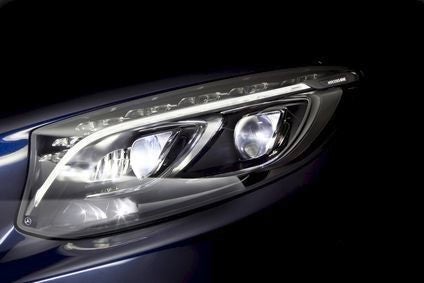
Daimler’s Mercedes-Benz plans soon to fit 84 LEDs per headlamp instead of the 24 in the current gridded high beam module in the CLS headlamp to boost light quality. In the medium term, as many as 1024 pixels per LED will enable optimum illumination of the road at every speed and in all traffic conditions – and without dazzling other road users, the automaker claimed.
Although night-time driving on country roads accounts for only 20% of total mileage in Germany, 40% of all fatal accidents occur there during the night, according to the German Federal Office for Roads and Traffic).

Discover B2B Marketing That Performs
Combine business intelligence and editorial excellence to reach engaged professionals across 36 leading media platforms.
“Enabling ideal visibility in all driving situations without dazzling other road users has always been our credo in developing new light systems,” said Uwe Kostanzer, head of light systems development at Mercedes-Benz. “We are pursuing the further development of LED technology to this end.”
In the near future, Mercedes-Benz will be incorporating an additional high range LED high beam into its LED headlamps. This additional high beam employs high-performance LEDs to provide high beam ranges of over 600m in driving situations without any oncoming traffic or vehicles ahead. In contrast to the current “laser headlamps”, LED technology achieves this performance at markedly lower costs and with a manageable degree of complexity. At the same time, it also enables automakers to exploit the legally permissible level of illumination in Europe virtually to the full. This applies irrespective of the light source employed in the headlamp for all manufacturers.
When it comes to the number of pixels, the same is true of LED headlamps as of a digital camera: the more the better, Mercedes said. The higher the number of individually controllable pixels, the more finely the light can be controlled and adapted to different conditions. A high resolution enables an increase in both precision and brilliance.
In 2014, Mercedes-Benz introduced innovative multibeam LED headlamps in the CLS-Class . These are fitted with 24 individual high-performance LEDs. Each one can be individually electronically controlled. ‘Gridding’ the light in this way allows the light distribution from the right and left headlamps to be controlled entirely separately and adapted to the traffic conditions with a high level of dynamism. This enables the individual areas of the road surface to be illuminated in a very specific manner. The headlamp control technology combines the gridded light source with the proven mechanical technology of the LED intelligent light system, and the high-performance LEDs provide for a range of 485 m.
Mercedes-Benz will soon launch multibeam LED headlamps with a gridded light source containing 84 LEDs, enabling even higher resolution of the light output. This will afford other road users even better protection from dazzling, while improving illumination of the road ahead for the driver. As a result of the absolutely freely configurable light distribution, it is possible for the first time to implement all high- and low-beam functions of the intelligent light system in entirely digital mode and without any mechanical actuators. This will make a wealth of new, adaptive light functions possible which will render night-time driving yet safer for both the driver and other road users.
This technology is set to advance at a rapid pace: In the medium term 1024 individually controllable pixels per LED chip will enable a further improvement in night-time visibility, resulting in further enhanced safety.
Partners Infineon, Osram, Fraunhofer Gesellschaft IZM, Hella and Daimler have just achieved a breakthrough in the “µAFS” research project in the form of a new type of LED chip with an extremely fine structure. Monolithically structured pixel LED semiconductor layers are built up on a silicon substrate which, via the integration of circuit parts, allows the selective control of more than 1024 individually addressable pixels per LED chip. This LED technology developed in the project sponsored by the Federal Ministry for Education and Research (BMBF) is to be installed and tested in a Mercedes-Benz experimental vehicle in 2015.
LED and partial high beam
At present, it is possible to fit up to 100 LEDs with luminous surfaces in the millimetre range behind a lens.
The idea of partial high beam goes back still further: in the face of ever denser traffic in the 1950s, computer pioneer Konrad Zuse (1910-1995) came up with a proposal for combining maximum illumination of the road with minimal irritation of oncoming traffic. Zuse employed several headlamps, each of which illuminated part of the road and could be switched off by means of photocells when the latter detected other cars within their range. In 1958 he had this ‘lighting system, photoelectrically controllable by counter light’ registered by the German patent office under the number 1190413. This partial high beam did not go into series production until this year, however, with the world premiere of the multibeam LED headlamp in the Mercedes-Benz CLS.






